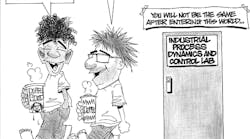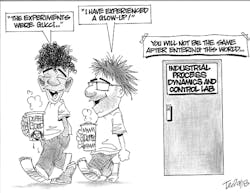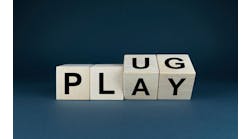This Control Talk column appeared in the October 2018 print edition of Control. To read more Control Talk columns click here or read the Control Talk blog here.
Greg: Peter, what do you want students to gain from your Process Dynamics and Control Laboratory course?
Peter: The course objectives are:
- Develop skill to understand the documentation required to design and operate a chemical process safely, efficiently and profitably.
- Use the process and control knowledge acquired in your educational careers to structure, analyze, design and implement a PID controller in a Distributed Control System (DCS).
- Be able to design processes that are safe, reliable and profitable to the owner/operator.
- Use process simulation software to design and analyze the PID controller that will be implemented on our process.
- Demonstrate strong written and oral communication skills.
Greg: Chris was coauthor of the first edition of my ISA book, “Advanced Temperature Measurement and Control,” creating the reader questions and answers for each chapter. I have had the pleasure of working with Chris during his early career at Monsanto. Chris, what do students get to work with in the labs?
Chris: The wet lab includes two trains. The first train consists of two tanks with the ability to pump water around via a positive-displacement pump and through the choice of a rotameter or magnetic flowmeter. The second train consists of two tanks and the ability pump water via a centrifugal pump with a VFD through the choice of a magmeter, Coriolis mass meter, vortex meter or orifice plate DP meter. On the second train, you can also valve in a plate-and-frame exchanger with steam to heat up the water, or two shell-and-tube exchangers with the ability to cool the water via chilled water. There are guided radar level transmitters and numerous temperature and pressure transmitters, some of which are wireless. One of the wireless pressure transmitters measures the dynamic pressure drop of parallel branches with different piping configurations. This experiment is intended to demonstrate the impact of process piping routing n system dynamics.
Greg: Peter, what are the lab experiments?
Peter: The course is partitioned into the following six areas of focus for getting the most out of wet lab:
- Process Instrumentation (2 weeks): This experiment will introduce the concepts of process instrumentation. The instruments to be studied and reported on are flow, level, pressure and temperature. There are five different types of flow transmitters, one type of level transmitter, two types of pressure transmitters and one type of temperature transmitter.
- Process Documentation (1 week): As discussed earlier, process documentation is essential for the safe and efficient operation of a chemical production unit. Process control documentation includes P&ID's, wiring drawings and loop drawings. In this experiment, you will experience what every new engineer working in a chemical production unit experiences, verifying and red-lining the process P&ID's. Each group will be given a P&ID of the control lab process, and will compare what is on the drawing with what is actually in the field. There are 14 intentional errors in the process P&ID. In this experiment, each group will identify the errors by red-lining the P&ID. Each group will then draft a memo to the lead designer in the experiment describing in more detail what the deficiency is and how the deficiency can be corrected.
- Pump Experiment (1 week): Develop a pump curve for the installed centrifugal pump in the control lab. Here, pump information given in the pump manual will be used to develop the pump curve. Each group will use the information provided in the pump manual to create a set of pump curves. The pump curves will then be used to determine the horsepower of the motor coupled to the pump. The lab report describes how pump curves are created and used. Included in the report are how conventional pump curves are developed and used. The experimental section explains why the pump curve set developed for our control lab pump is unconventional, and shows the results of the control lab pump curve development.
- Pressure Drop Experiment (1 week): The path a fluid travels through a pipe sets the pressure drop across the pipe for a given flow velocity, pipe diameter, and number and type of fittings and valves in the line. In this experiment, the pressure drop in lines with different fittings will be measured and compared with the calculated pressure for the given line. The Crane manual is useful for this experiment. Results will be presented in the lab report.
- Fitting a Process Model (2 weeks): An important aspect of process control engineering is the design of closed-loop controllers to actually control the process. There are several ways to accomplish this, and these methods will be discussed during the lectures. One important method is to use step-response data to fit a first-order model with dead time (FOPDT) to the sub-process we want to control. The model can describe a flow, level, pressure or temperature response to a process perturbation. The simulation results will be compared with the process results using an Excel scatter-plot showing the simulated and actual process data on one graph.
- PID Controller Design and Final Group Project (2 weeks): This experiment is actually part two of the previous experiment. Using the FOPDT model developed earlier, a PID controller will be designed and implemented. The controller design will be influenced by the actual sub-process. The controller design will be implemented in the DCS and the controller design verified that it can both reject process disturbances and move the process to a new setpoint in a stable manner. The lab report will detail the above steps of this experiment, and provide the reader with conclusions based on controller performance.
Greg: Here are some student comments on the course. To translate their slang, see the dictionary below this month's cartoon.
Students: I don’t want to throw shade but TBH it was cringey to rethink out dime process operating points. I was V dead to dealing with deadtime and shook waiting for the final value. Then I realized the industrial knowledge was extra and what we ended up with was fleeky. The guest lecturers had a Stan for their mentor. I am finna as well. When I tell other students about the lab, I will say “It’s lit.”
Greg: Chris, what are some future plans?
Chris: We want students to learn how to use a virtual plant (digital twin) to develop a deeper understanding of process relationships and dynamics and controller tuning and performance. The virtual plant uses industry’s most extensive used dynamic simulation software and digital twin of the actual DCS. By using a digital twin instead of an emulation that is trying to duplicate control actions from scratch, the incredible flexibility and capability of a modern DCS can be used with modules and graphics freely exchanged between the actual lab and virtual lab experiments.
We will start with a virtual plant of the wet lab. Next year we will be automating absorber columns in a showcase lab with temperature, pressure and flow control. A virtual plant will then be developed to educate users on the more complex behavior of columns.
A Model Predictive Control will be developed by Greg for both the heat exchanger in the wet lab and the absorber in the column lab to automatically adapt key model parameters to improve model fidelity.
Greg: Dynamic first principle simulations have played a huge role in my career for last 40 years. Fortunately, simulation and resulting process control improvements were main part of culture in Engineering Technology at Monsanto and then in Solutia. I was able to carry this over to my second career in Research and Development at Emerson Process Solutions where the virtual plant has greatly expanded the opportunities as seen in the Control article “Virtual Plant Virtuosity.” A charge balance to show the effect of conjugate salts on often extremely challenging pH systems in the Chemical Processing article “Improve pH Control” for future demos to explore all types of pH systems. Backlash-stiction and variable deadtime objects have been created study complex valve dynamics potentially devastating to loop response in the Control article “How to specify valves and positioners that do not compromise control.” This month there is a Control article “Compressor modeling and control” that reveals by the addition of a momentum balance the largely unknown path on a compressor map to the left of the surge line during damaging surge cycles offering insight as to what is really important in how fast the control system needs to be and proactive strategies needed that go beyond conventional PID control.
Dictionary:
Cringey = awkward, uncomfortable, cringe-worthy
Dead = overwhelmed or exhausted
Dime = 10/10 rating of attractiveness
Extra = over the top
Fleeky = amazing or great
Finna = going to or about to, short for “fixing to”
Glow up = an incredible transformation
Gucci = good, cool
It’s lit = cool, awesome, great
Shook = shocked, upset
Stan = having an intense fandom for a person
TBH = to be honest
Throw shade = talking badly about a thing
V = very







